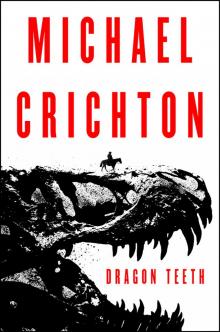- Home
- Michael Crichton
The Lost World Page 18
The Lost World Read online
Page 18
“But it’s much too shiny,” Levine said. “We should have made it matte black.”
Thorne said, “Eddie, we need to hide this.”
“Want to spray it, Doc? I think I brought some black paint.”
Levine shook his head. “No, then it’ll smell. How about those palms?”
“Sure, we can do that.” Eddie walked to a stand of nearby palms, and began to hack away big fronds with his machete.
Kelly stared up at the aluminum strut assembly. “It’s great,” she said. “But what is it?”
“It’s a high hide,” Levine said. “Come on.” And he began to climb the scaffolding.
* * *
The structure at the top was a little house, its roof supported by aluminum bars spaced four feet apart. The floor of the house was also made of aluminum bars, but these were closer together, about six inches apart. Their feet threatened to slip through, so Levine took the first of the bundles of fronds that Eddie Carr was raising on a rope, and used them to make a more complete floor. The remaining fronds he tied to the outside of the house, concealing its structure.
Arby and Kelly stared out at the animals. From their vantage point, they could look across the whole valley. There was a distant herd of apatosaurs, on the other side of the river. A cluster of triceratops browsed to the north. Nearer the water, some duck-billed dinosaurs with long crests rising above their heads moved forward to drink. A low, trumpeting cry from the duckbills floated across the valley toward them: a deep, unearthly sound. A moment later, there was an answering cry, from the forest at the opposite side of the valley.
“What was that?” Kelly said.
“Parasaurolophus,” Levine said. “It’s trumpeting through its nuchal crest. Low-frequency sound carries a long distance.”
To the south, there was a herd of dark-green animals, with large curved protruding foreheads, and a rim of small knobby horns. They looked a little like buffalo. “What do you call those?” Kelly said.
“Good question,” Levine said. “They are most likely Pachycephalosaurus wyomingensis. But it’s difficult to say for sure, because a full skeleton for these animals has never been recovered. Their foreheads are very thick bone, so we’ve found many domed cranial fragments. But this is the first time I’ve ever seen the whole animal.”
“And those heads? What are they for?” Arby said.
“Nobody knows,” Levine said. “Everyone has assumed they’re used for butting, for intraspecies fighting among males. Competition for females, that sort of thing.”
Malcolm climbed up into the hide. “Yes, butting heads,” he said sourly. “Just as you see them now.”
“All right,” Levine said, “so they’re not butting heads at the moment. Perhaps their breeding season is concluded.”
“Or perhaps they don’t do it at all,” Malcolm said, staring at the green animals. “They look pretty peaceful to me.”
“Yes,” Levine said, “but of course that doesn’t mean a thing. African buffalo appear peaceful most of the time, too—in fact, they usually just stand motionless. Yet they’re unpredictable and dangerous animals. We have to presume those domes exist for a reason—even if we’re not seeing it now.”
Levine turned to the kids. “That’s why we made this structure. We want to make round-the-clock observations on the animals,” he said. “To the extent possible, we want a full record of their activities.”
“Why?” Arby said.
“Because,” Malcolm said, “this island presents a unique opportunity to study the greatest mystery in the history of our planet: extinction.”
“You see,” Malcolm said, “when InGen shut down their facility, they did it hastily, and they left some live animals behind. That was five or six years ago. Dinosaurs mature rapidly; most species attain adulthood in four or five years. By now, the first generation of InGen dinosaurs—bred in a laboratory—has attained maturity, and has begun to breed a new generation, entirely in the wild. There is now a complete ecological system on this island, with a dozen or so dinosaur species living in social groups, for the first time in sixty-five million years.”
Arby said, “So why is that an opportunity?”
Malcolm pointed across the plain. “Well, think about it. Extinction is a very difficult research topic. There are dozens of competing theories. The fossil record is incomplete. And you can’t perform experiments. Galileo could climb the tower of Pisa and drop balls to test his theory of gravity. He never actually did it, but he could have. Newton used prisms to test his theory of light. Astronomers observed eclipses to test Einstein’s theory of relativity. Testing occurs throughout science. But how can you test a theory of extinction? You can’t.”
Arby said, “But here . . .”
“Yes,” Malcolm said. “What we have here is a population of extinct animals artificially introduced into a closed environment, and allowed to evolve all over again. There’s never been anything like it in all history. We already know these animals became extinct once. But nobody knows why.”
“And you expect to find out? In a few days?”
“Yes,” Malcolm said. “We do.”
“How? You don’t expect them to become extinct again, do you?”
“You mean, right before our eyes?” Malcolm laughed. “No, no. Nothing like that. But the point is, for the first time we aren’t just studying bones. We’re seeing live animals, and observing their behavior. I have a theory, and I think that even in a short time, we will see evidence for that theory.”
“What evidence?” Kelly said.
“What theory?” Arby said.
Malcolm smiled at them. “Wait,” he said.
The Red Queen
The apatosaurs had come down to the river in the heat of the day; their graceful curving necks were reflected in the water as they bent to drink. Their long, whip-like tails swung back and forth lazily. Several younger apatosaurs, much smaller than the adults, scampered about in the center of the herd.
“Beautiful, isn’t it?” Levine said. “The way it all fits together. Just beautiful.” He leaned over the side and shouted to Thorne, “Where’s my mount?”
“Coming up,” Thorne said.
The rope now brought up a heavy wide-based tripod, and a circular mount on top. There were five video cameras atop the mount, and dangling wires leading to solar panels. Levine and Malcolm began to set it up.
“What happens to the video?” Arby said.
“The data gets multiplexed, and we uplink it back to California. By satellite. We’ll also hook into the security network. So we’ll have lots of observation points.”
“And we don’t have to be here?”
“Right.”
“And this is what you call a high hide?”
“Yes. At least, that’s what scientists like Sarah Harding call it.”
Thorne climbed up to join them. The little shelter was now quite crowded, but Levine didn’t seem to notice. He was entirely focused on the dinosaurs; he turned a pair of binoculars on the animals spread across the plain. “Just as we thought,” he said to Malcolm. “Spatial organization. Infants and juveniles in the center of the herd, protective adults on the periphery. The apatosaurs use their tails as defense.”
“That’s the way it looks.”
“Oh, there’s no question about it,” Levine said. He sighed. “It’s so agreeable to be proven right.”
On the ground below, Eddie unpacked the circular aluminum cage, the same one they had seen in California. It was six feet tall and four feet in diameter, constructed of one-inch titanium bars. “What do you want me to do with this?” Eddie said.
“Leave it down there,” Levine said. “That’s where it belongs.”
Eddie set the cage upright in the corner of the scaffolding. Levine climbed down.
“And what’s that for?” Arby said, looking down. “Catching a dinosaur?”
“In point of fact, just the opposite.” Levine clipped the cage to the side of the scaffolding. He swung the doo
r open and shut, testing it. There was a lock in the door. He checked the lock, too, leaving the key in place, with its dangling elastic loop. “It’s a predator cage, like a shark cage,” Levine said. “If you’re down here walking around and anything happens, you can climb in here, and you’ll be safe.”
“In case what happens?” Arby said, with a worried look.
“Actually, I don’t think anything will happen,” Levine said, climbing back up. “Because I doubt the animals will pay any attention to us, or to this little house, once the structure’s been concealed.”
“You mean they won’t see it?”
“Oh, they’ll see it,” Levine said, “but they’ll ignore it.”
“But if they smell us . . .”
Levine shook his head. “We sited the hide so the prevailing wind is toward us. And you may have noticed these ferns have a distinct smell.” It was a mild, slightly tangy odor, almost like eucalyptus.
Arby fretted. “But suppose they decide to eat the ferns?”
“They won’t,” Levine said. “These are Dicranopterus cyatheoides. They’re mildly toxic and cause a rash in the mouth. In point of fact, there’s a theory that their toxicity first evolved back in the Jurassic, as a defense against dinosaur browsers.”
“That’s not a theory,” Malcolm said. “It’s just idle speculation.”
“There’s some logic behind it,” Levine said. “Plant life in the Mesozoic must have been severely challenged by the arrival of very large dinosaurs. Herds of giant herbivores, each animal consuming hundreds of pounds of plant matter each day, would have wiped out any plants that didn’t evolve some defense—a bad taste, or nettles, or thorns, or chemical toxicity. So perhaps cyatheoides evolved its toxicity back then. And it’s very effective, because contemporary animals don’t eat these ferns, anywhere on earth. That’s why they’re so abundant. You may have noticed.”
“Plants have defenses?” Kelly said.
“Of course they do. Plants evolve like every other form of life, and they’ve come up with their own forms of aggression, defense, and so on. In the nineteenth century, most theories concerned animals—nature red in tooth and claw, all that. But now scientists are thinking about nature green in root and stem. We realize that plants, in their ceaseless struggle to survive, have evolved everything from complex symbiosis with other animals, to signaling mechanisms to warn other plants, to outright chemical warfare.”
Kelly frowned. “Signaling? Like what?”
“Oh, there are many examples,” Levine said. “In Africa, acacia trees evolved very long, sharp thorns—three inches or so—but that only provoked animals like giraffes and antelope to evolve long tongues to get past the thorns. Thorns alone didn’t work. So in the evolutionary arms race, the acacia trees next evolved toxicity. They started to produce large quantities of tannin in their leaves, which sets off a lethal metabolic reaction in the animals that eat them. Literally kills them. At the same time, the acacias also evolved a kind of chemical warning system among themselves. If an antelope begins to eat one tree in a grove, that tree releases the chemical ethylene into the air, which causes other trees in the grove to step up the production of leaf tannin. Within five or ten minutes, the other trees are producing more tannin, making themselves poisonous.”
“And then what happens to the antelope? It dies?”
“Well, not any more,” Levine said, “because the evolutionary arms race continued. Eventually, antelopes learned that they could only browse for a short time. Once the trees started to produce more tannin, they had to stop eating it. And the browsers developed new strategies. For example, when a giraffe eats an acacia tree, it then avoids all the trees downwind. Instead, it moves on to another tree that is some distance away. So the animals have adapted to this defense, too.”
“In evolutionary theory, this is called the Red Queen phenomenon,” Malcolm said. “Because in Alice in Wonderland the Red Queen tells Alice she has to run as fast as she can just to stay where she is. That’s the way evolutionary spirals seem. All the organisms are evolving at a furious pace just to stay in the same balance. To stay where they are.”
Arby said, “And this is common? Even with plants?”
“Oh yes,” Levine said. “In their own way, plants are extremely active. Oak trees, for example, produce tannin and phenol as a defense when caterpillars attack them. A whole grove of trees is alerted as soon as one tree is infested. It’s a way to protect the entire grove—a kind of cooperation among trees, you might say.”
Arby nodded, and looked out from the high hide at the apatosaurs, still by the river below. “So,” Arby said, “is that why the dinosaurs haven’t eaten all the trees off this island? Because those big apatosaurs must eat a lot of plants. They have long necks to eat the high leaves. But the trees hardly look touched.”
“Very good,” Levine said, nodding. “I noticed that myself.”
“Is that because of these plant defenses?”
“Well, it might be,” Levine said. “But I think there is a very simple explanation for why the trees are preserved.”
“What’s that?”
“Just look,” Levine said. “It’s right before your eyes.”
Arby picked up the binoculars and stared at the herds. “What’s the simple explanation?”
“Among paleontologists,” Levine said, “there’s been an interminable debate about why sauropods have long necks. Those animals you see have necks twenty feet long. The traditional belief has been that sauropods evolved long necks to eat high foliage that could not be reached by smaller animals.”
“So?” Arby said. “What’s the debate?”
“Most animals on this planet have short necks,” Levine said, “because a long neck is, well, a pain in the neck. It causes all sorts of problems. Structural problems: how to arrange muscles and ligaments to support a long neck. Behavioral problems: nerve impulses must travel a long way from the brain to the body. Swallowing problems: food has to go a long way from the mouth to the stomach. Breathing problems: air has to be pulled down a long windpipe. Cardiac problems: blood has to be pumped way up to the head, or the animal faints. In evolutionary terms, all this is very difficult to do.”
“But giraffes do it,” Arby said.
“Yes, they do. Although giraffe necks are nowhere near this long. Giraffes have evolved large hearts, and very thick fascia around the neck. In effect, the neck of a giraffe is like a blood-pressure cuff, going all the way up.”
“Do dinosaurs have the same cuff?”
“We don’t know. We assume apatosaurs have huge hearts, perhaps three hundred pounds or more. But there is another possible solution to the problem of pumping blood in a long neck.”
“Yes?”
“You’re looking at it right now,” Levine said.
Arby clapped his hands. “They don’t raise their necks!”
“Correct,” Levine said. “At least, not very often, or for long periods. Of course, right now the animals are drinking, so their necks are down, but my guess is that if we watch them for an extended period we’ll find they don’t spend much time with their necks raised high.”
“And that’s why they don’t eat the leaves on the trees!”
“Right.”
Kelly frowned. “But if their long necks aren’t used for eating, then why did they evolve them in the first place?”
Levine smiled. “There must be a good reason,” he said. “I believe it has to do with defense.”
“Defense? Long necks?” Arby stared. “I don’t get it.”
“Keep looking,” Levine said. “It’s really rather obvious.”
Arby peered through binoculars. He said to Kelly, “I hate it when he tells us it’s obvious.”
“I know,” she said, with a sigh.
Arby glanced over at Thorne, and caught his eye. Thorne made a V with his fingers, and then pushed one finger, tilting it over. The movement forced the second finger to shift, too. So the two fingers were connected. . . .
> If it was a clue, he didn’t get it. He didn’t get it. He frowned.
Thorne mouthed: “Bridge.”
Arby looked, and watched the whip-like tails swing back and forth over the younger animals. “I get it!” Arby said. “They use their tails for defense. And they need long necks to counterbalance the long tails. It’s like a suspension bridge!”
Levine squinted at Arby. “You did that very fast,” he said.
Thorne turned away, hiding a smile.
“But I’m right . . .” Arby said.
“Yes,” Levine said, “your view is essentially correct. Long necks exist because the long tails exist. It’s a different situation in theropods, which stand on two legs. But in quadrupeds, there needs to be a counterbalance for the long tail, or the animal would simply tip over.”
Malcolm said, “Actually, there is something much more puzzling about this apatosaur herd.”
“Oh?” Levine said. “What’s that?”
“There are no true adults,” Malcolm said. “Those animals we see are very large by our standards. But in fact, none of them has attained full adult size. I find that perplexing.”
“Do you? It doesn’t trouble me in the least,” Levine said. “Unquestionably, it is simply because they haven’t had enough time to reach maturity. I’m sure apatosaurs grow more slowly than the other dinosaurs. After all, large mammals like elephants grow more slowly than small ones.”
Malcolm shook his head. “That’s not the explanation,” he said.
“Oh? Then what?”
“Keep looking,” Malcolm said, pointing out over the plain. “It’s really rather obvious.”
The kids giggled.
Levine gave a little shiver of displeasure. “What is obvious to me,” he said, “is that none of the species appear to have attained full adulthood. The triceratops, the apatosaurs, even the parasaurs are a bit smaller than one would expect. This argues for a consistent factor: some element of diet, the effects of confinement on a small island, perhaps even the way they were engineered. But I don’t consider it particularly remarkable or worrisome.”

 Dragon Teeth
Dragon Teeth Jurassic Park
Jurassic Park Micro
Micro The Great Train Robbery
The Great Train Robbery The Andromeda Strain
The Andromeda Strain The Lost World
The Lost World Congo
Congo Travels
Travels Timeline
Timeline Sphere
Sphere Westworld
Westworld Prey
Prey State Of Fear
State Of Fear Next
Next Disclosure
Disclosure Pirate Latitudes
Pirate Latitudes The Terminal Man
The Terminal Man Five Patients
Five Patients Rising Sun
Rising Sun Binary
Binary The Andromeda Evolution
The Andromeda Evolution Airframe
Airframe Easy Go
Easy Go Drug of Choice
Drug of Choice Odds On: A Novel
Odds On: A Novel Scratch One
Scratch One Dealing or The Berkeley-to-Boston Forty-Brick Lost-Bag Blues
Dealing or The Berkeley-to-Boston Forty-Brick Lost-Bag Blues Venom Business
Venom Business Grave Descend
Grave Descend Gold - Pirate Latitudes
Gold - Pirate Latitudes Binary: A Novel
Binary: A Novel Zero Cool
Zero Cool Delos 1 - Westworld
Delos 1 - Westworld